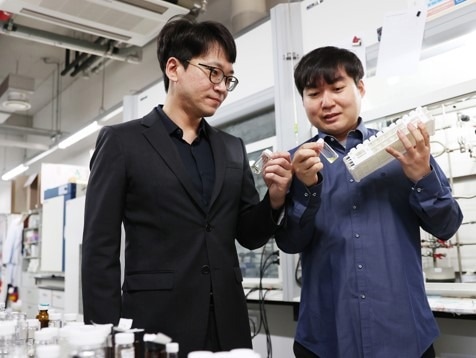Polymers, which are huge molecules built up of smaller molecules that repeat, are present in almost everything humans use in their daily lives. Polymers can be either natural or man-made. DNA, proteins, and materials like silk, gelatin, and collagen are examples of natural polymers, often known as biopolymers.
 Minjoong Shin (right), the first author of the paper, and Professor Myungeun Seo looking at the aqueous solutions of amphiphilic random copolymers. Image Credit: The Korea Advanced Institute of Science and Technology.
Minjoong Shin (right), the first author of the paper, and Professor Myungeun Seo looking at the aqueous solutions of amphiphilic random copolymers. Image Credit: The Korea Advanced Institute of Science and Technology.
Synthetic polymers are the building blocks of a variety of materials, notably plastic, which are utilized to produce everything including toys to industrial fiber cables to brake pads.
The monomers are linked together in a chain as polymers are produced through a process called polymerization. The structure of the polymer dictates its distinct physical and chemical characteristics as the chain evolves.
How polymers are formed, constructed, and how they generate their distinct qualities are all being studied by researchers. Scientists can find new uses for polymers and produce new materials that can be employed in a range of sectors by comprehending this knowledge.
Researchers reveal a novel structure identified in an aqueous solution of an amphiphilic copolymer dubbed a bilayer-folded lamellar mesophase that was discovered using a random copolymer sequence in an article published in Nature Communications on May 4th, 2022.
A new mesophase is an important discovery as it shows a new way for molecules to self-organize. We were particularly thrilled to identify this bilayer-folded lamellar phase because pure bilayer membranes are difficult to fold thermodynamically.
Myungeun Seo, Professor, Department of Chemistry, The Korea Advanced Institute of Science and Technology
The sequence of monomers inside the copolymer is considered to be responsible for the mesophase structure. The arrangement of different monomers in the chain that makes up a copolymer is significant and can affect what the copolymer can do. Many copolymers are random, meaning their structure is determined by how monomers interact with one another.
In this situation, the hydrophobic monomers interact with one another to form copolymer chains that hide the hydrophobic domain from water. Researchers have discovered that as the structure becomes more complicated, a visible order emerges, allowing monomers to be matched up with the correct pair.
While we tend to think random means disorder, here we showed that a periodic order can spontaneously arise from the random copolymer sequence based on their collective behavior. We believe this comes from the sequence matching problem: finding a perfectly complementary pair for a long sequence is nearly impossible.
Myungeun Seo, Professor, Department of Chemistry, The Korea Advanced Institute of Science and Technology
This gives the newly found mesophase its distinct structure. The copolymer folds spontaneously, resulting in a multilamellar structure separated by water. Plate-like folds are referred to as multilamellar structures, and the folded layers mount on top of each other. The resultant mesophase is birefringent, meaning it refracts light, liquid crystalline in appearance, and viscoelastic, meaning it is viscous and elastic at the same time.
Researchers aim to learn more about this new mesophase in the future and figure out how to influence its outcome. As additional sequences are studied, it is feasible that more mesophases will be discovered as more is learned about the mesophase and how it forms.
One of the obvious questions for us is how to control the folding frequency and adjust the folded height, which we are currently working to address. Ultimately, we want to understand how different multinary sequences can associate with another to create order and apply the knowledge to develop new materials.
Myungeun Seo, Professor, Department of Chemistry, The Korea Advanced Institute of Science and Technology
This study was financed by Korea’s National Research Foundation, Ministry of Education, and Ministry of Science and ICT.
Journal Reference:
Shin, M., et al. (2022) Bilayer-folded lamellar mesophase induced by random polymer sequence. Nature Communications. doi.org/10.1038/s41467-022-30122-z.